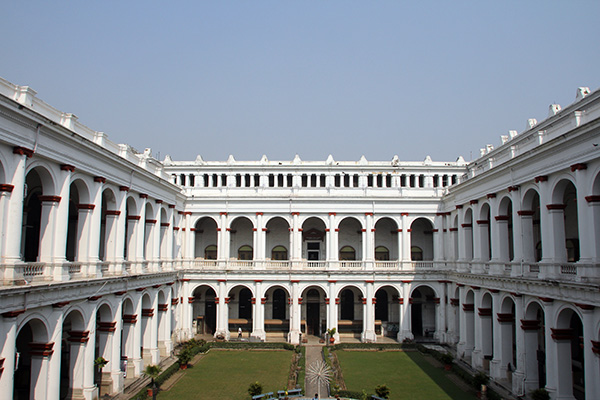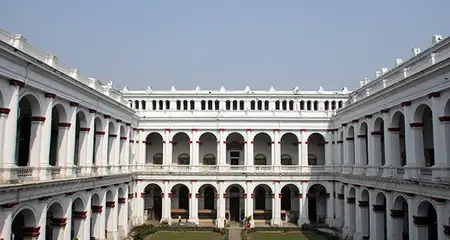The Indian Museum in Kolkata is the largest and the earliest multipurpose museum in India as well as the Asia-Pacific region, and also one of the oldest in the world. Established over 200 years ago by the Asiatic Society of Bengal, the museum is also known by the name the Imperial Museum. It houses a comprehensive collection of artifacts that narrate the social and cultural history of India from pre-historic times. Unlike most other museums in the country which are dedicated to specific themes or areas, the Indian Museum displays objects from a wide range of fields, from art and anthropology to zoology and botany. It counts among the top attractions to visit once you step out of your hotels in Kolkata to explore the city.
Looking for more details about this popular museum in Kolkata? Read further…
Indian Museum, Kolkata Information:
| Location | Jawaharlal Nehru Road, Park Street, Kolkata |
| Year of Establishment | 1814 |
| Established by | The Asiatic Society of Bengal |
| Founder Curator | Nathaniel Wallich, a Danish Botanist |
| Collections | Art, Anthropology, Archaeology, Zoology, Geology, and Economic Botany |
| Also known as | Jadu-ghar, Ajabghar, Imperial Museum |
| Status | Organization under the Ministry of Culture and an Institute of National Importance |
| Timings | 10:00 am to 6:30 pm (Tuesday to Friday); 10:00 am to 8:00 pm (Saturdays and Sundays); closed on Mondays and public holidays |
| Entry Fee | ₹ 50 for Indian adults; ₹ 500 for foreigners; ₹ 20 for kids above the age of 5 years |
| Photography | ₹ 50 for smartphone with camera; ₹ 100 for camera |
| Videography | ₹ 2000 for small video camera; ₹ 5000 for video camera with stand |
| Guide Service | Free |
| Library Timings | 10:00 am to 5:00 pm; closed on second Saturdays, Sundays, and public holidays |
| Library Membership Fee | ₹ 50 per person |
| Other Facilities | Information Desk, Drinking Water, Washrooms, Cafeteria, Cloakroom, Museum Shop, Guide Service, and facilities for differently abled and visually impaired visitors |
Indian Museum, Kolkata: History
The origins of Indian Museum can be traced back to 1814 when it was founded by the Asiatic Society of Bengal. The Society was established in 1784 with the objective of spreading knowledge and preserving the natural and cultural heritage of mankind. Even though the idea of establishing a museum was put forward by the members in 1796, the Society could come up with its own building on Park Street only in 1808.
After another 6 years, Danish botanist by the name Nathaniel Wallich wrote a letter to the Society advocating the importance of a museum. He also volunteered to serve as the honorary curator and provide botanical specimens from his own collections. The museum was established in the premises of the Asiatic Society building and Wallich was appointed as the superintendent and the founder curator. Back then, it was called the Asiatic Society Museum and later came to be known as the Imperial Museum.
Soon after its establishment, attempts were made to collect interesting artifacts and objects from across the country. Many donors, both Europeans and Indians, also gifted valuable items from their collections.
It was in 1867 that the foundation of the present building was laid in Chowringhee Road. The construction of the current three-storied building, which was designed by the famous architect W.L. Grandville, was completed in 1875 and the collections were moved from the Asiatic Society Building to the new one. On 1st April 1878, the museum was opened to the public with two galleries. Over the years, several other galleries were added.
Indian Museum, Kolkata: Today
Today, the Imperial Museum founded by the Asiatic Society is known as the Indian Museum and is an institution that functions under India Government’s Ministry of Culture. It serves as one of the top tourist attractions in Kolkata and a haven for history and science enthusiasts.
Currently, the museum displays its vast collection of artifacts under 6 categories, namely Art, Anthropology, Archaeology, Zoology, Geology, and Economic Botany. It houses several galleries where enormous collections of international and indigenous objects are displayed, ranging from armors, antiques, and Mughal paintings to fossils, mummies, and skeletons.
There is a library at the museum, near the Coin Gallery, where you can find a huge collection of over 50,000 books, rare publications, and journals. You can access this collection upon paying a nominal membership fee. If you want to purchase souvenirs such as postcards, photographs, art albums, children’s books, etc., you will find them all in the Museum Shop.
The Indian Museum also conducts exhibitions throughout the year related to various fields, such as cinema, sculpture, photography, crafts, biological diversity, and literature, to mention a few.
Collections and Galleries at Indian Museum, Kolkata
- Bird Gallery (Zoology Section)
- Botanical Gallery (Botany Section)
- Coin Gallery (Archaeology Section)
- Bronze Gallery (Archaeology Section)
- Barhut Gallery (Archaeology Section)
- Egypt Gallery (Archaeology Section)
- Insect Gallery (Zoology Section)
- Mammal Gallery (Zoology Section)
- Mask Gallery (Anthropology Section)
- Paintings Gallery (Art Section)
- Textile Gallery (Art Section)
- Long Archaeology Gallery (Archaeology Section)
- Gandhara Gallery (Archaeology Section)
- Gallery of Decorative Art (Art Section)
In addition to these, the museum has several other galleries such as Invertebrate Fossils Gallery, Musical Instrument Gallery, Human Evolution Gallery, Pre and Proto-Historic Gallery, Mughal Painting Gallery, Cultural Anthropology Gallery, Fish Gallery, Rocks and Minerals Gallery, Amphibia and Reptilia Gallery, Terracotta and Minor Arts Gallery, and Siwalik Gallery, to mention a few.
Note: Please note that some of the galleries might be closed for renovation at the time of your visit.
Lesser-known Facts about Indian Museum, Kolkata
- The Coin Gallery at the Indian Museum houses the largest collection of Indian coins in the whole world.
- Nathaniel Wallich, the founder curator of the museum, was also involved in the development of the Botanical Gardens of Kolkata.
- At the time of its inception, Nathaniel Wallich donated over 40 botanical specimens from his personal collection to the museum.
- The mummy housed within the Indian Museum is among the 6 Egyptian mummies in the country. It was a gift to the Asiatic Society in 1834 by a British officer by the name Lieutenant EC Archbold.
- The zoological collection at the museum led to the formation of the Zoological Survey of India in 1916, which is currently a government organization under the Ministry of Environment, Forest, and Climate Change.
Attractions near Indian Museum, Kolkata
- Maidan (1.5 km)
- Birla Planetarium (1.5 km)
- Paul’s Cathedral (1.6 km)
- Writer’s Building (1.9 km)
- Eden Gardens (2 km)
- Town Hall (2.2 km)
- College Street (3 km)
- Victoria Memorial (3.7 km)
- Princep Ghat (3.8 km)
- Marble Palace (3.8 km)
- Fort William (3.8 km)
- Howrah Bridge (4.3 km)
- Alipore Zoo (6 km)
The Indian Museum in Kolkata is not just another museum. It is a haven of knowledge for people of all ages and will keep you engaged for hours. Also, it is located in the Park Street Area where you can find some of the best restaurants and pubs in Kolkata. Some of our suggestions include Someplace Else, The Myx, Hard Rock Café, Olypub, and Roxy, all of which are located within a walking distance of the museum.
Also Read- Top 34 Things to do in Kolkata
So, go ahead and plan a day at this oldest and largest museum in India.


























